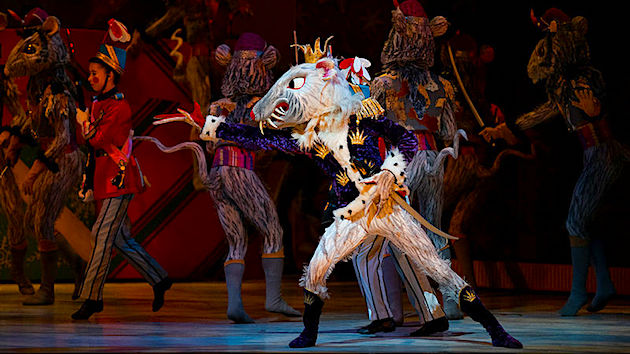
To simplify the history of the ballet called Nutcracker, let’s simply note that the San Francisco Ballet premiered the very first full-length version in the United States at the War Memorial Opera House, San Francisco, on Dec. 24, 1944.

To elaborate on what is now the 75th anniversary, let’s say that the company’s celebration, launched Wednesday night, is an all-out extravaganza, saluting original choreographer and artistic director Willam Christensen, present choreographer and Artistic Director Helgi Tomasson, whose Nutcracker premiered in 2004, and all the creators — choreographers to musicians, teachers to dancers — in between. The array of young dancers from the San Francisco Ballet School, plunging joyfully down the Stahlbaums’ stairs in Act 1, epitomized the thousands of hours and artists, sponsors, benefactors, and enablers (we’re talking about you, ballet parents) invested in every production since.
And even before then, for we should properly note that the first Nutcracker (Shchelkunchik in Russian) was premiered in 1892 by the Imperial Ballet at the Mariinsky Theatre in St. Petersburg. It was choreographed by Lev Ivanov with a libretto by Marius Petipa. The music, as ever, was by Peter Ilyich Tchaikovsky. Its reception, frankly, was less than warm.

No longer. The San Francisco Ballet’s Nutcracker, like hundreds of others nationwide, is a love object and holiday icon, this year gorgeously lavished with gewgaws as never before, beginning in the lobby with bows and bangles and Christmas trees, photo ops with the dancers or in a sleigh, tiny ballerinas in glorious costumes ($21.50) hanging from a gift shop Christmas tree, and larger (but still tiny) tots in their holiday finery, sliding across the marble floors and nibbling on cookies. Claras (25!) and other dancers from Nutcrackers past were also there. Among them was Charlotte Ogden Moore, 19, a Clara in 2012 and 2013 and a pre-professional San Francisco Ballet School alum who credits Tomasson’s leadership for her love of the art form. She wants to remain involved with ballet in a supportive role, perhaps on the board, suggested her mother, who was with her. Managing her hectic schedule of school and dance classes, Charlotte said, taught her lasting skills in time management and working with her teachers.

The school remains a key to the company’s strength, with 65 percent of the dancers attending. It brings an underlying glow, a unanimity of technique and artistry, not to mention spirit, to all the proceedings, but especially to this year’s Nutcracker.
That it remains physically unchanged from its 2004 premiere becomes an annually more appealing gift from its designers, Michael Yeargan, Martin Pakledinaz, James F. Ingalls, and Wendall K. Harrington, as San Francisco changes with the city’s times and fortunes. How lovely to return to 1915, year of the S.F. Exposition, to almost breathe in the fog, to see the Farallon Islands and the houses on the hills at twilight, to watch the bustle on the narrow street. The San Francisco Ballet Orchestra was beautifully led by Martin West, principal conductor and music director.

But most important, how lovely to watch the dancers young and old, from Abby Cannon’s vivacious preteen Clara and Shane Wexelman’s irrepressibly bratty brother Fritz to friends and family, precise yet natural in their dances. How groovy to find the clock shop in the hands of Tiit Helimets, an Uncle Drosselmeyer whose brush cut and zesty body language makes him a silver fox of a magician as he brings the Nutcracker doll (Hansuke Yamamoto) to life, joining dancing dolls, the rubber-limbed Max Cauthorn and dainty automaton Lauren Parrott.
After the vanquishing of the King of the Mice (Nathan Remez, emerging from the prompter’s box with evil in mind, but ending up upended, tail and feet waving in midair), the Nutcracker reveals himself to be none other than Luke Ingham, gallant as Clara’s princely escort, welcoming the King and Queen of the Snow (Carlo di Lanno and the eternally supple, glorious Yuan Yuan Tan) before hopping aboard the crystal-headed horse-drawn sleigh and dashing through an absolute blizzard, juiced up, perhaps, for year 75. Ingham becomes a terrific half of the final pas de deux, with Mathilde Froustey brilliantly commanding the stage as queen of the realm, overcoming a nasty slip during the Grand Pas de Deux. Sasha de Sola’s Sugar Plum Fairy, sparkly in pink tutu, was a child’s dream.

Equally happy and charming star turns came from flawlessly presented international delights like the Spanish variation; Arabian, with Kimberly Marie Olivier; Chinese, with the boundlessly bounding Lonnie Weeks and a capering five-kid dragon; Esteban Hernandez, endlessly leaping with Davide Occhipinti and Myles Thatcher in the Russian dance, created by Anatole Vilzak; the Frenchy-French trio of Kamryn Baldwin, Maggie Weirich, and Ami Yuki; and Louis Schilling, maneuvering his Madame du Cirque tent to take in his mischievous little buffoons, and the scene-stealing dancing bear (Diego Cruz, flirting over his shoulder at the audience).
Sixteen waltzing flowers made the rain outside go away, at least for a while, and so did the jolly balloon drop at the curtain call, wreathing the cheering audience in floating globes of candy-cane red and white and smiles, smiles, smiles.





